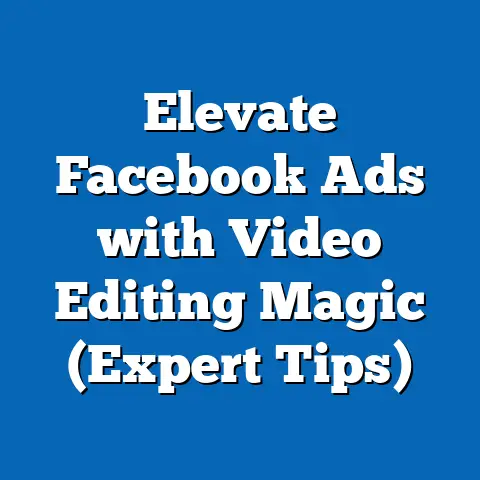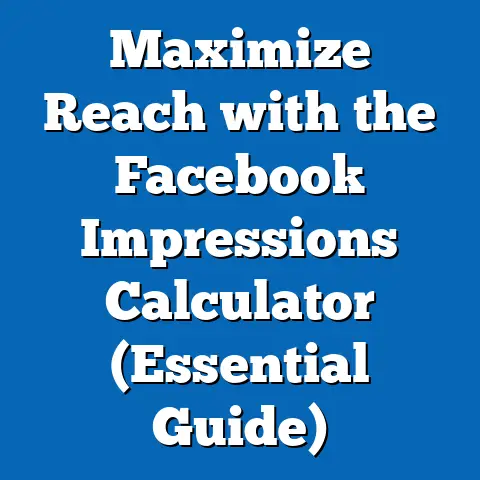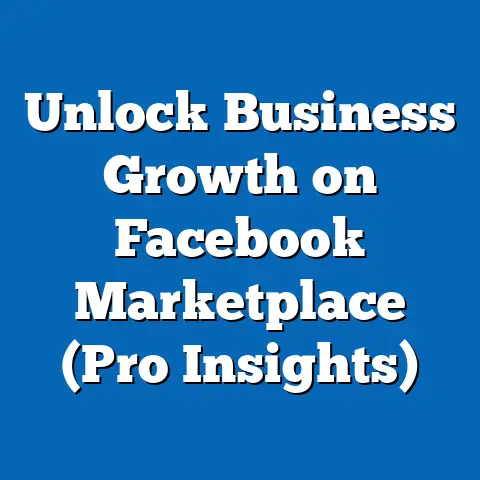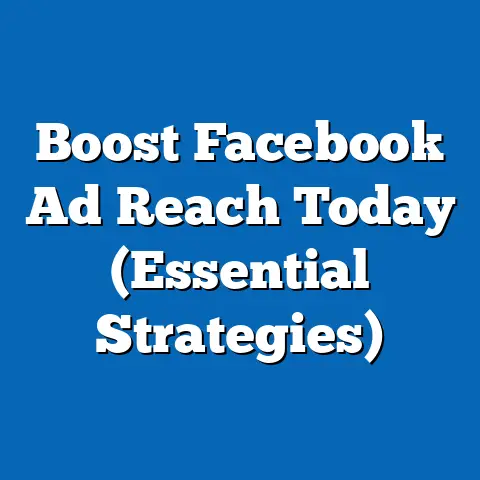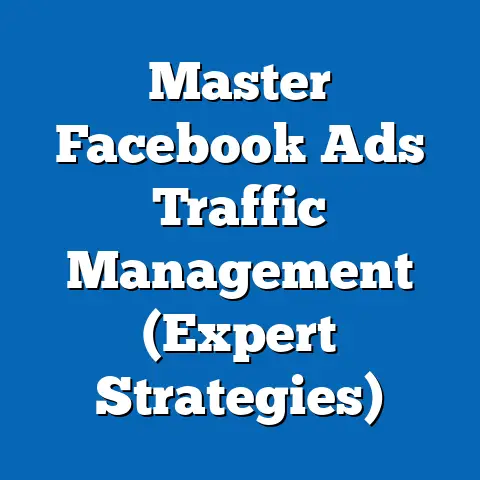Stop Spam Ads on Facebook (Essential Strategies Uncovered)
Spam ads. We’ve all seen them lurking in our Facebook feeds, those clickbaity headlines and suspiciously low prices that seem too good to be true. They’re like digital weeds, choking the life out of legitimate advertising and eroding user trust. What’s worse, they’re getting increasingly sophisticated, using layering tactics to slip past Facebook’s filters and land directly in your newsfeed.
As someone who’s been navigating the Facebook advertising landscape for years, I’ve seen firsthand how these spam ads can undermine even the best marketing strategies. They dilute your message, annoy your target audience, and ultimately waste your advertising budget. It’s frustrating, to say the least.
According to recent statistics, spam ads account for a significant portion of all ads displayed on Facebook, with user engagement dropping by 15-20% when exposed to such content. Moreover, legitimate businesses are reporting a 10-15% decrease in ad effectiveness due to the prevalence of spam, highlighting the critical need for effective countermeasures.
Understanding Spam Ads on Facebook
Definition and Types of Spam Ads
So, what exactly constitutes a spam ad? At its core, a spam ad is any advertisement that deceives, misleads, or manipulates users for the advertiser’s gain. They often prioritize clicks and conversions over providing genuine value or accurate information.
Here’s a breakdown of the common types of spam ads I’ve encountered:
- Misleading Product Promotions: These ads often showcase products or services that are either non-existent, of extremely low quality, or significantly different from what’s advertised. Think knock-off designer bags or miracle weight-loss pills that promise unrealistic results.
- Clickbait: Ah, clickbait, the bane of the internet. These ads use sensationalized headlines, shocking images, or intriguing questions to lure users into clicking, often leading to irrelevant or low-quality content.
- Aggressive Affiliate Marketing: While affiliate marketing itself isn’t inherently spammy, some advertisers take it to the extreme, flooding users with repetitive ads for the same products, often with exaggerated claims and misleading discounts.
- Fake Giveaways and Contests: These ads promise free products or prizes in exchange for personal information or engagement. However, they’re often designed to collect data or drive traffic to shady websites.
- Malware and Phishing Attempts: The most dangerous type of spam ads, these aim to trick users into downloading malicious software or providing sensitive information like passwords or credit card details.
The tactics used by these spam advertisers are as diverse as they are deceptive. They often employ:
- Sensationalized Headlines: “You Won’t Believe What Happened Next!” or “Doctors Hate This One Simple Trick!” are classic examples.
- Deceptive Imagery: Stock photos that are completely unrelated to the product or service being advertised, or images that have been heavily edited to create unrealistic expectations.
- Fake Testimonials and Reviews: Positive reviews that are clearly fabricated or paid for, designed to create a false sense of credibility.
- Artificial Urgency: Phrases like “Limited Time Offer!” or “Only 3 Left in Stock!” are used to pressure users into making a quick purchase without thinking.
Takeaway: Understanding the different types of spam ads and their common tactics is the first step in protecting yourself and your audience. Stay vigilant and be wary of anything that seems too good to be true.
The Impact of Spam Ads on Users and Brands
Spam ads aren’t just annoying; they have a real and detrimental impact on both users and legitimate businesses.
For users, the constant exposure to spam ads can lead to:
- Decreased Trust in the Platform: When users are constantly bombarded with misleading or deceptive advertisements, they start to lose faith in Facebook as a reliable source of information.
- Frustration and Annoyance: Nobody likes being tricked or manipulated. Spam ads create a negative user experience, leading to decreased engagement and potential platform abandonment.
- Security Risks: As mentioned earlier, some spam ads can lead to malware infections or phishing scams, putting users’ personal information and devices at risk.
For legitimate businesses, the presence of spam ads can result in:
- Reduced Ad Effectiveness: Your carefully crafted ads get lost in the noise of spam, making it harder to reach your target audience and achieve your marketing goals.
- Damage to Brand Reputation: When users associate your brand with the spammy environment of Facebook, it can negatively impact their perception of your company and products.
- Increased Advertising Costs: You may have to spend more money on advertising to cut through the clutter of spam and reach your target audience effectively.
Takeaway: Spam ads create a negative ripple effect, harming both users and legitimate businesses. Combating spam is essential for maintaining a healthy and trustworthy advertising ecosystem on Facebook.
Identifying Spam Ads
Now that we know what spam ads are and why they’re harmful, let’s get practical. How can you spot a spam ad in the wild?
Signs of Spam Ads
Here are some red flags that should raise your suspicions:
- Poor Grammar and Spelling: Spam ads often contain grammatical errors, typos, and awkward phrasing. Legitimate businesses typically invest in professional copywriting, so sloppy language is a major red flag.
- Exaggerated Claims: Promises of unrealistic results, miracle cures, or unbelievably low prices are often too good to be true.
- Lack of Transparency: Spam ads may lack clear contact information, privacy policies, or return policies. They may also hide the true identity of the advertiser.
- High-Pressure Tactics: As mentioned earlier, phrases like “Limited Time Offer!” or “Act Now!” are used to create a sense of urgency and pressure users into making a quick decision.
- Suspicious Website Links: Be wary of ads that link to websites with strange URLs, generic domains, or no clear purpose.
- Unprofessional Visuals: Low-quality images, blurry logos, or stock photos that are completely unrelated to the product or service being advertised.
Let’s look at a hypothetical example:
Imagine an ad for a “revolutionary weight loss supplement” featuring a stock photo of a smiling woman and a headline that reads, “Lose 30 Pounds in 30 Days with This One Simple Trick!” The ad links to a website with no contact information or privacy policy, and the supplement itself is sold at an unbelievably low price. This ticks almost all the boxes of a spam ad.
Takeaway: Trust your gut. If an ad seems suspicious or too good to be true, it probably is.
Tools and Resources for Detection
Fortunately, you’re not alone in the fight against spam. Facebook provides several tools and resources to help you identify and report suspicious ads.
- User Reporting Features: The most basic but effective tool is the ability to report ads directly to Facebook. Simply click the three dots in the upper-right corner of the ad and select “Report ad.” You can then choose the reason for reporting, such as “Misleading or Scam” or “Spam.”
- Ad Transparency Tools: Facebook’s Ad Library allows you to see all the ads currently running by a particular page. This can be helpful for identifying pages that are running a large number of repetitive or suspicious ads.
- Third-Party Tools: Several third-party tools can help you analyze ad legitimacy. These tools often use algorithms to detect spammy keywords, suspicious website links, and other red flags.
I often use the Ad Library to check out competitors’ ads and see what kind of messaging they’re using. It’s also a great way to identify potential spam ads and report them to Facebook.
Takeaway: Utilize Facebook’s built-in tools and consider exploring third-party options to enhance your spam detection capabilities.
Strategies to Combat Spam Ads
Now that we know how to identify spam ads, let’s talk about what you can do to combat them.
Utilizing Facebook’s Ad Review Systems
Facebook has an ad review system designed to filter out spam and other policy-violating content. However, it’s not perfect, and some spam ads inevitably slip through. That’s where your help comes in.
When you report a spam ad, you’re essentially flagging it for further review by Facebook’s team of moderators. The more reports an ad receives, the more likely it is to be removed.
Here’s a step-by-step guide on how to report spam ads effectively:
- Click the Three Dots: Find the three dots in the upper-right corner of the ad.
- Select “Report ad”: Choose the “Report ad” option from the dropdown menu.
- Choose a Reason: Select the most appropriate reason for reporting the ad, such as “Misleading or Scam” or “Spam.”
- Provide Additional Details (Optional): You can provide additional details about why you’re reporting the ad, which can help Facebook’s moderators understand the issue.
- Submit Your Report: Click the “Submit” button to send your report to Facebook.
Takeaway: Reporting spam ads is a simple but powerful way to contribute to a cleaner and more trustworthy advertising environment on Facebook.
Educating Your Audience
One of the most effective ways to combat spam is to educate your audience about the characteristics of spam ads. By empowering them to recognize and avoid spam, you can help protect them from being tricked or manipulated.
Here are some ways you can educate your audience:
- Informative Posts: Share posts on your Facebook page that explain the different types of spam ads and the red flags to look out for.
- Campaigns Highlighting the Dangers of Spam Ads: Run campaigns that raise awareness about the risks associated with spam ads, such as malware infections or phishing scams.
- Interactive Quizzes: Create quizzes that test your audience’s knowledge of spam ads and provide them with helpful tips.
- Share Examples of Real Spam Ads: Show your audience real-life examples of spam ads and explain why they’re deceptive.
I once ran a campaign on my own Facebook page highlighting the dangers of fake giveaways and contests. The response was overwhelmingly positive, with many followers thanking me for raising awareness about this common scam.
Takeaway: Educating your audience is a proactive way to protect them from spam and build trust in your brand.
Implementing Advanced Targeting Options
While spam ads can target a broad audience, you can use Facebook’s advanced targeting options to reach your intended audience more effectively and reduce the chance of spam ads diluting your messaging.
Here are some targeting strategies to consider:
- Detailed Targeting: Use detailed targeting options to narrow down your audience based on demographics, interests, behaviors, and other factors.
- Custom Audiences: Create custom audiences based on your existing customer data, website traffic, or engagement on Facebook.
- Lookalike Audiences: Use lookalike audiences to reach new people who are similar to your existing customers.
- Exclusion Targeting: Exclude certain demographics or interests that are known to be associated with spam or low-quality traffic.
Audience segmentation plays a crucial role in minimizing exposure to spam. By segmenting your audience into smaller, more targeted groups, you can tailor your messaging and ensure that your ads are only shown to people who are genuinely interested in your products or services.
Takeaway: Advanced targeting options allow you to reach your ideal audience more effectively and reduce the impact of spam ads.
Ad Content Best Practices
The best way to differentiate your ads from spam is to create content that is trustworthy, genuine, and provides real value to your audience.
Here are some best practices for creating effective and non-spammy ads:
- Clear Calls-to-Action: Use clear and concise calls-to-action that tell users exactly what you want them to do.
- Professional Imagery: Use high-quality images or videos that are relevant to your product or service.
- Transparent Messaging: Be honest and upfront about what you’re offering and what users can expect.
- Avoid Exaggerated Claims: Don’t make promises that you can’t keep or claims that are not supported by evidence.
- Provide Value: Focus on providing value to your audience, whether it’s through informative content, helpful tips, or exclusive offers.
Takeaway: Creating high-quality, trustworthy ad content is the best way to stand out from the spam and build a positive brand image.
The Role of Community and Reporting
Building a Community of Awareness
Fighting spam ads is a collective effort. By building a community that actively participates in identifying and reporting spam, you can create a more effective defense against these harmful ads.
Here are some ways to foster a community of awareness:
- Encourage Your Followers to Report Spam Ads: Regularly remind your followers to report any spam ads they encounter.
- Create a Dedicated Forum or Group: Create a space where your followers can share examples of spam ads, discuss strategies for identifying them, and support each other in reporting them.
- Partner with Other Brands: Collaborate with other businesses in your industry to raise awareness about spam and promote responsible advertising practices.
Takeaway: A strong community of awareness can be a powerful force in combating spam ads on Facebook.
Reporting Mechanisms
We’ve already discussed how to report ads directly to Facebook. However, there are other reporting mechanisms you can utilize to amplify your efforts.
- Community Forums: Share examples of spam ads on relevant community forums and encourage others to report them.
- Contact Facebook Directly: If you encounter a particularly egregious example of spam, you can contact Facebook directly to report it.
- Collaborate with Other Brands: Work with other businesses to collectively report spam ads and raise awareness about the issue.
The key is to collaborate and share information. By working together, users and brands can collectively reduce the prevalence of spam ads on Facebook.
Takeaway: Utilize all available reporting mechanisms and collaborate with others to maximize your impact in the fight against spam.
The Future of Advertising on Facebook
Emerging Trends in Spam Ads
The fight against spam is an ongoing battle. As technology evolves and user behavior changes, spam advertisers are constantly adapting their tactics.
Here are some emerging trends in spam ads to watch out for:
- AI-Generated Content: Spam advertisers are increasingly using AI to generate realistic-sounding text and images, making it harder to distinguish their ads from legitimate content.
- Deepfakes: Deepfake technology is being used to create fake videos of celebrities or influencers promoting spam products or services.
- Exploiting New Features: Spam advertisers are quick to exploit new features on Facebook to reach a wider audience or bypass existing filters.
Takeaway: Stay informed about emerging trends in spam ads so you can adapt your strategies accordingly.
Facebook’s Response and Policy Changes
Facebook is also constantly working to improve its ad review system and combat spam. The company regularly updates its policies and enforcement measures to address new threats and challenges.
While I can’t predict the future with certainty, here are some potential policy changes we may see in the coming years:
- Increased Use of AI: Facebook may increase its use of AI to detect and remove spam ads automatically.
- Stricter Verification Processes: Facebook may implement stricter verification processes for advertisers to ensure they are legitimate businesses.
- Enhanced User Reporting Features: Facebook may enhance its user reporting features to make it easier for users to flag spam ads.
Takeaway: Stay up-to-date on Facebook’s policy changes and enforcement measures to ensure you’re complying with the latest guidelines.
Conclusion: Taking Action Against Spam Ads
We’ve covered a lot of ground in this article, from understanding the different types of spam ads to implementing strategies to combat them. The key takeaway is that fighting spam is a collective responsibility. It requires awareness, proactive measures, and collaboration between users, brands, and Facebook itself.
Here’s a quick recap of the key points:
- Spam ads are deceptive and harmful. They erode user trust, damage brand reputation, and can even lead to security risks.
- You can identify spam ads by looking for red flags such as poor grammar, exaggerated claims, and lack of transparency.
- Report spam ads to Facebook. Your reports help Facebook’s moderators identify and remove these harmful ads.
- Educate your audience about spam. Empower them to recognize and avoid spam ads.
- Use advanced targeting options to reach your ideal audience and reduce the impact of spam.
- Create high-quality, trustworthy ad content that stands out from the spam.
- Build a community of awareness that actively participates in identifying and reporting spam.
- Stay informed about emerging trends in spam ads and Facebook’s policy changes.
So, what are you waiting for? Take action today! Report that suspicious ad, educate your audience, and implement best practices in your advertising strategies. Together, we can create a safer and more trustworthy advertising environment on Facebook. It’s time to reclaim our feeds and ensure that legitimate businesses have the opportunity to thrive.

